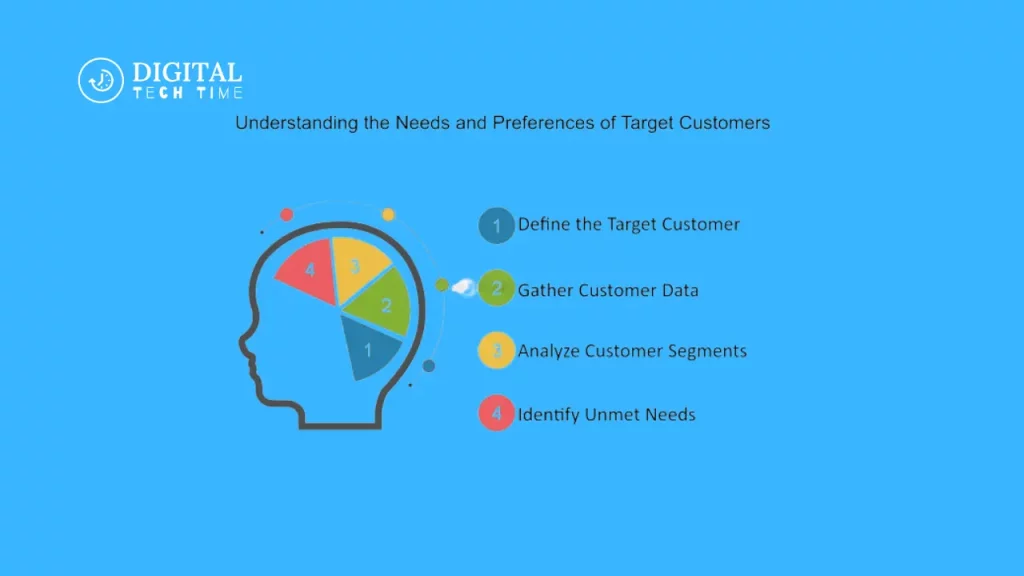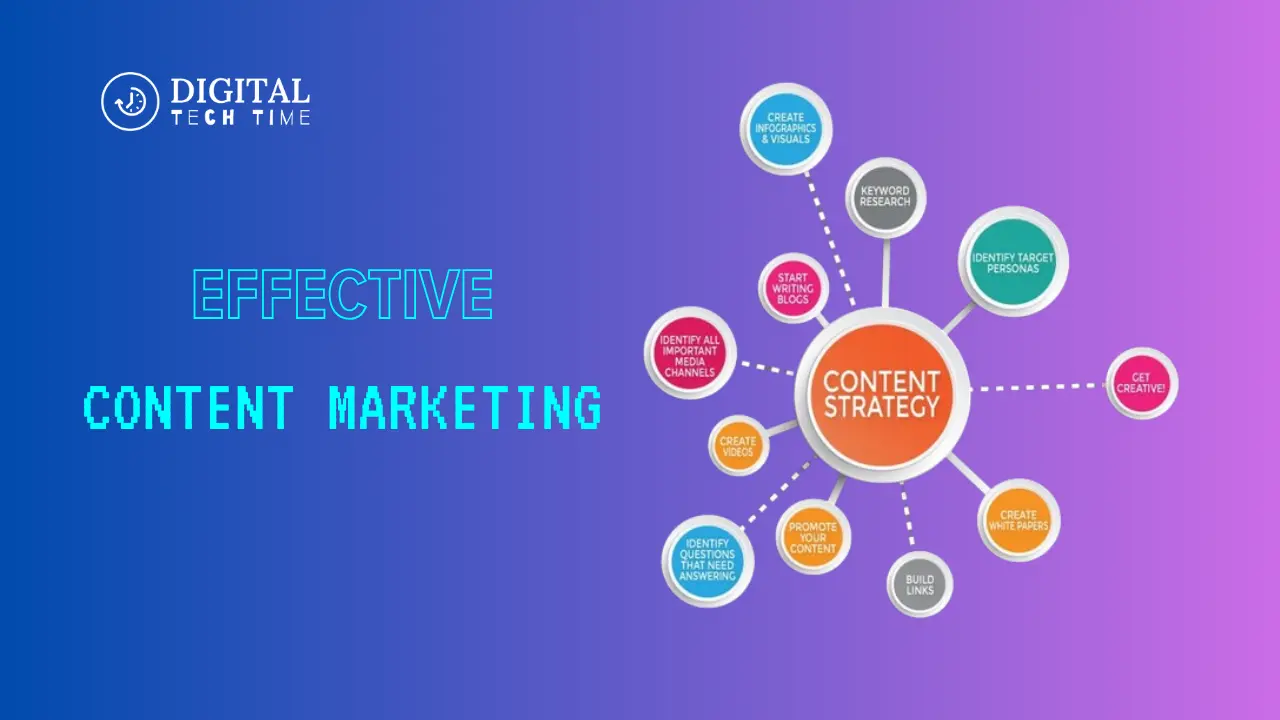Effective Content Marketing: Strategies for Success
Content marketing is crucial for businesses to establish their online presence, engage with their target audience, and drive conversions in the digital age. It involves understanding the audience, crafting compelling narratives, and delivering value at every touchpoint. Effective content marketing builds trust, authority, and credibility, fostering long-lasting customer relationships. It also significantly impacts search engine optimization (SEO) efforts,
Driving organic traffic and increasing visibility among potential customers. Well-crafted, keyword-optimized content enhances user experience, leading to higher engagement and conversion rates.
Table of Contents
Critical components of successful content marketing strategies
To achieve success with content marketing, it’s crucial to have a comprehensive strategy in place that encompasses various vital components. These components work together to create a cohesive and impactful content marketing approach:
- Clear goals and objectives: Defining measurable goals and objectives is the foundation of any successful content marketing strategy. These goals include increasing brand awareness, generating leads, improving customer engagement, or boosting sales.
- Target audience identification: Understanding your target audience is essential for creating relevant and valuable content. By conducting thorough market research and analyzing customer data, you can gain insights into their pain points, preferences, and behaviours, enabling you to tailor your content to their needs.
- Content planning and creation: Developing a content calendar and creating a diverse range of content formats (e.g., blog posts, videos, infographics, podcasts) is crucial for keeping your audience engaged and catering to different learning styles.
- Content distribution and promotion: Once you’ve created high-quality content, it’s essential to distribute it through various channels, such as social media, email marketing, influencer partnerships, and paid advertising, to maximize its reach and visibility.
- Measurement and analysis: Regularly measuring and analyzing the performance of your content marketing efforts is vital for making data-driven decisions and optimizing your strategy. Key metrics to track include website traffic, engagement rates, lead generation, and conversions.
By integrating these components into your content marketing strategy, you can create a cohesive and practical approach that resonates with your target audience and drives tangible results for your business.
Also Read: Decoding Windows 10: A Guide to Finding Where Themes Stored
Identifying your target audience and understanding their needs
One of the most critical components of an effective content marketing strategy is identifying and understanding your target audience. With a deep understanding of your audience’s needs, pain points, and preferences, creating content that truly resonates and provides value becomes easier.
To identify your target audience, start by analyzing your existing customer base. Look for standard demographics, interests, and behaviours to help create audience personas. Additionally, market research should be conducted to identify potential new segments and gain insights into their characteristics and preferences.

Once you’ve identified your target audience, developing a comprehensive understanding of their needs, challenges, and goals is essential. This can be achieved through various methods, such as:
- Customer surveys and interviews: Directly engaging with your audience through surveys and interviews can provide invaluable insights into their pain points, preferences, and content consumption habits.
- Social media monitoring: Monitoring social media conversations and engaging with your audience on these platforms can help you understand their interests, concerns, and the types of content they find valuable.
- Website analytics: Analyzing website traffic data, user behaviour, and content performance can reveal valuable insights into your audience’s preferences and engagement patterns.
- Competitor analysis: Studying your competitors’ content marketing strategies and the types of content that resonate with their audiences can provide valuable insights for your approach.
By truly understanding your target audience’s needs, you can create content that addresses their pain points, provides solutions to their challenges, and aligns with their interests and preferences. This, in turn, will help you build a loyal and engaged audience, fostering trust and credibility for your brand.
Developing a content marketing plan
Developing a comprehensive content marketing plan is essential for ensuring the success of your content marketing efforts. A well-crafted plan serves as a roadmap, guiding your content creation, distribution, and promotion strategies while aligning them with your business objectives.
To develop an effective content marketing plan, follow these steps:
- Define your goals and objectives: Start by clearly defining your content marketing goals and objectives. These include increasing brand awareness, generating leads, improving customer engagement, or boosting sales. Ensure your goals are specific, measurable, achievable, relevant, and time-bound (SMART).
- Conduct a content audit: Evaluate your existing content assets, including blog posts, videos, whitepapers, and social media posts. Identify gaps, areas for improvement, and opportunities for repurposing or updating content.
- Develop buyer personas: Create detailed buyer personas representing your target audience segments. These personas should include demographic information, pain points, interests, and content consumption preferences.
- Create a content calendar: Develop a content calendar that outlines the types of content you’ll create, the topics you’ll cover, and the frequency and schedule for publishing. Ensure your content aligns with your buyer personas and addresses their needs at different stages of the buyer’s journey.
- Identify content distribution channels: Determine the channels you’ll use to distribute and promote your content, such as social media platforms, email marketing, influencer partnerships, or paid advertising.
- Define your content creation process: Establish a streamlined process for content creation, including creativity, research, writing, editing, and publishing. Assign roles and responsibilities to ensure efficient collaboration and quality control.
- Set performance metrics: Identify the key performance indicators (KPIs) you’ll use to measure the success of your content marketing efforts. These could include website traffic, engagement rates, lead generation, and conversions.
- Allocate resources: Ensure you have the budget, personnel, and tools to execute your content marketing plan effectively.
By developing a comprehensive content marketing plan, you can ensure that your content efforts are aligned with your business objectives, target the right audience, and deliver measurable results.
Also Read: How to Trim MP3 Files on Windows 10
Creating high-quality and engaging content
Creating high-quality and engaging content is at the heart of any successful content marketing strategy. It’s essential to produce content that captures your audience’s attention and provides value, educates, and inspires them to take action.

To create compelling content, follow these best practices:
- Focus on quality over quantity: While consistency is important, prioritize quality over quantity. Creating fewer but highly valuable and engaging pieces of content will yield better results than churning out a high volume of mediocre content.
- Understand your audience’s preferences: Tailor your content format, tone, and style to your target audience’s preferences. For example, if your audience prefers visual content, create engaging videos, infographics, or interactive content.
- Tell compelling stories: Storytelling is a powerful tool for capturing your audience’s attention and creating an emotional connection with your brand. Craft narratives that resonate with your audience’s experiences, challenges, and aspirations.
- Provide actionable insights and solutions: Your content should offer practical advice, tips, and solutions that address your audience’s pain points and help them achieve their goals. Share your expertise and industry knowledge to position your brand as a trusted authority.
- Incorporate multimedia elements: Enhance your content with multimedia elements such as images, videos, infographics, and interactive tools. These elements can make your content more engaging, visually appealing, and easier to consume.
- Optimize for search engines: Ensure your content is optimized by incorporating relevant keywords, meta descriptions, and alt tags. This will improve your content’s visibility and help your target audience find it more easily.
- Encourage engagement and interaction: Include calls-to-action (CTAs) and prompts for engagement, such as comments, social shares, or email subscriptions. This will foster community and encourage your audience to interact with your brand.
Creating high-quality and engaging content can establish your brand as a trusted authority in your industry, build a loyal audience, and drive conversions and business growth.
Optimizing content for search engines
While creating high-quality and engaging content is crucial, optimizing that content for search engines is equally important. Search engine optimization (SEO) ensures that your content is visible and easily discoverable by your target audience when they search for relevant topics online.
To optimize your content for search engines, follow these best practices:
- Conduct keyword research: Identify the keywords and phrases your target audience uses to search for information related to your products, services, or industry. Use these keywords strategically throughout your content, including titles, headings, and body text.
- Optimize metadata: Craft compelling and keyword-rich meta titles and meta descriptions for each piece of content. These elements are displayed in search engine results and can entice users to click through to your website.
- Structure content for readability: Use headings, subheadings, and bullet points to break up your content and make it easier to scan and read. Search engines favour well-structured and easily digestible content.
- Incorporate internal and external links: Link to relevant pages within your website (internal links) and authoritative external sources. This helps search engines understand the context and relationships between different pieces of content.
- Optimize images and multimedia: Include descriptive alt text for images and transcripts for videos and audio files. This makes your multimedia content accessible to search engines and users with disabilities.
- Leverage schema markup: Schema markup is a structured data format that helps search engines better understand the content on your website. Implementing schema markup can enhance your search engine visibility and provide rich snippets in search results.
- Monitor and adjust: Regularly monitor your content’s search engine performance and adjust as needed. Analyze search engine rankings, click-through rates, and user behaviour to identify areas for improvement.
By optimizing your content for search engines, you can increase its visibility, drive more organic traffic to your website, and ultimately reach a more significant portion of your target audience.
Promoting content through various channels
Creating high-quality, engaging, and SEO-optimized content is the first step in an effective content marketing strategy. To maximize the impact of your content and reach your target audience, it’s crucial to promote it through various channels.

Here are some effective channels and strategies for promoting your content:
- Social media: Leverage the power of social media platforms like Facebook, Twitter, LinkedIn, and Instagram to share your content and engage with your audience. Develop a social media content calendar and tailor your approach to each platform’s unique audience and content formats.
- Email marketing: Build an email list of subscribers interested in your content and industry. Send regular email newsletters or updates featuring your latest content and exclusive offers or sneak peeks to keep your audience engaged.
- Influencer partnerships: Collaborate with influencers or thought leaders in your industry who have a solid following and align with your brand values. Invite them to contribute to your content or share your content with their audience.
- Content syndication: Partner with reputable websites or publications in your industry to syndicate your content, increasing its reach and exposing it to new audiences.
- Paid advertising: Consider investing in paid advertising channels like Google Ads, social media advertising, or native advertising to promote high-performing content and drive targeted traffic to your website.
- Guest blogging: Contribute guest posts or articles to authoritative blogs or publications in your industry. This can help you tap into new audiences, build backlinks, and establish your brand as a thought leader.
- Repurposing content: Repurpose your existing content into different formats, such as turning a blog post into a video or an infographic. This allows you to cater to different audience preferences and extend the reach of your content.
When promoting your content, it’s essential to track and analyze the performance of each channel and adjust your strategy accordingly. Monitor metrics like website traffic, engagement rates, and conversions to determine which channels are most effective for your audience and content.
Measuring and analyzing the effectiveness of your content marketing efforts
Measuring and analyzing your content marketing efforts’ effectiveness is crucial for understanding your strategy’s impact and making data-driven decisions to optimize your approach. By tracking the right metrics and analyzing the performance of your content, you can identify what resonates with your audience, where improvements are needed, and how to allocate your resources effectively.
Here are some key metrics to consider when measuring the effectiveness of your content marketing efforts:
- Website traffic: Monitor the number of visitors to your website, including the sources of traffic (organic search, social media, referrals, etc.). This can help you understand the channels driving the most traffic to your content.
- Engagement metrics: Track metrics such as time on page, bounce rate, and scroll depth to gauge how engaged your audience is with your content. High engagement levels indicate that your content is resonating with your audience.
- Lead generation and conversions: Measure the number of leads generated and conversions (e.g., sales, subscriptions, or downloads) from your content marketing efforts. This can help you understand the direct impact of your content on your business goals.
- Social media engagement: Monitor social media metrics like shares, likes, comments, and mentions to understand how your audience interacts with your content on different platforms.
- Search engine rankings: Track your content’s performance in search engine results by monitoring your rankings for relevant keywords. Improved rankings can indicate effective SEO optimization and increased visibility.
- Return on investment (ROI): Calculate your content marketing efforts’ return on investment (ROI) by comparing the costs associated with creating and promoting your content to the revenue or leads generated.
Consider using tools like Google Analytics, social media analytics platforms, and content marketing software to effectively analyze your content marketing performance. These tools can provide detailed insights into your audience’s behaviour, content consumption patterns, and the overall impact of your content marketing strategy.
Regularly review and adjust your content marketing strategy based on the data and insights gathered. Identify areas for improvement, experiment with new tactics, and continuously optimize your approach to achieve better results and maximize the impact of your content marketing efforts.
Content marketing case studies and success stories
To illustrate the power and effectiveness of content marketing, let’s explore some real-world case studies and success stories from businesses across various industries:
- Hubspot: Hubspot, a leading provider of inbound marketing and sales software, has built a massive following and established itself as a thought leader in the marketing industry through its content marketing efforts. Their blog, which features educational articles, guides, and resources, attracts over 7 million monthly visitors. Hubspot’s content marketing strategy has driven brand awareness, generated leads, and fostered customer loyalty.
- Glossier: Glossier, a direct-to-consumer beauty brand, has leveraged content marketing to build a loyal community of customers and advocates. Their blog, “Into the Gloss,” features beauty tips, product reviews, and personal stories that resonate with their target audience. By creating authentic and relatable content, Glossier has fostered a solid emotional connection with its customers, leading to impressive sales growth and brand loyalty.
- Moz: Moz, a leading provider of SEO software and resources, has built its reputation as an authority in the SEO industry through its content marketing efforts. Their blog, “Moz Blog,” features in-depth articles, whitepapers, and industry studies that educate and empower their audience. Moz’s commitment to creating high-quality, actionable content has helped them attract a dedicated following and establish themselves as a trusted source in the SEO community.
- GoPro: GoPro, the action camera company, has leveraged user-generated content to fuel its content marketing strategy. The company has built a vast library of inspiring and engaging content by encouraging customers to share their adventures and experiences captured with GoPro cameras. This user-generated content showcases the capabilities of GoPro’s products. It fosters a sense of community and brand loyalty among its customers.
- Marriott International: Marriott International, a global hospitality company, has embraced content marketing to showcase its brand and inspire travel experiences. Their content platform, “Marriott Traveler,” features articles, videos, and multimedia content that explores destinations, cultures, and travel experiences. By providing valuable and inspiring content, Marriott has strengthened its brand identity and fostered deeper connections with its target audience.

These case studies highlight the diverse ways in which businesses across various industries have successfully implemented content marketing strategies. By creating valuable, engaging, and audience-centric content, these companies have built brand awareness, fostered customer loyalty, generated leads, and ultimately driven business growth.
Content marketing tools and resources for success
To execute an effective content marketing strategy, leveraging the right tools and resources is essential. These tools can streamline your content creation, distribution, and analysis processes, enabling you to work more efficiently and achieve better results.
Here are some valuable content marketing tools and resources to consider:
- Content management systems (CMS): Platforms like WordPress, HubSpot CMS, and Drupal allow you to create, manage, and publish content on your website with ease. These systems offer user-friendly interfaces, built-in SEO tools, and integration with various content marketing tools.
- Content creation tools: Tools like Google Docs, Grammarly, and Hemingway App can help you streamline the writing process and ensure high-quality, error-free content. Tools like Canva, Adobe Creative Cloud, and Visme can assist you in creating visually appealing graphics, infographics, and multimedia content.
- Content distribution and promotion tools: Social media management tools like Hootsuite, Buffer, and Sprout Social can help you schedule and publish content across multiple platforms. Email marketing tools like Mailchimp, Constant Contact, and HubSpot can help you build and manage email lists, create newsletters, and track engagement.
- SEO tools: Tools like Ahrefs, SEMrush, and Moz can help you conduct keyword research, analyze your website’s SEO performance, and identify opportunities for improvement. Tools like Yoast SEO and RankMath can also help you optimize your content for search engines directly within your CMS.
- Content analytics and reporting tools: Google Analytics, Hotjar, and Mixpanel can provide valuable insights into your website traffic, user behaviour, and content performance. These tools can help you identify which content resonates with your audience and make data-driven decisions to optimize your strategy.
- Project management and collaboration tools: Tools like Trello, Asana, and Notion can help you organize your content calendar, assign tasks, and collaborate with your team members effectively.
- Online communities and resources: Platforms like Content Marketing Institute, Copyblogger, and Growthbunkers offer a wealth of educational resources, industry insights, and networking opportunities for content marketers.
By leveraging the right tools and resources, you can streamline your content marketing processes, enhance your team’s productivity, and gain valuable insights to improve your strategy continually. However, it’s essential to carefully evaluate your specific needs and choose tools that align with your budget, team size, and overall content marketing goals.
Frequently Asked Questions
Q: What is content marketing?
A: Content marketing is a strategic approach to creating and distributing valuable, relevant, consistent content to attract and retain a clearly defined audience, ultimately driving profitable customer action.
Q: Why is content marketing important?
A: Content marketing is essential because it helps businesses build trust, establish authority, and foster relationships with their target audience. It also supports SEO efforts, drives organic traffic, and leads to increased conversions and sales.
Q: What types of content can be used in content marketing?
A: Content marketing can involve various formats, including blog posts, articles, videos, podcasts, infographics, whitepapers, case studies, social media updates, and more.
Q: How do I measure the success of my content marketing efforts?
A: Key metrics to measure the success of your content marketing efforts include website traffic, engagement rates (time on page, bounce rate, scroll depth), lead generation, conversions, social media engagement, search engine rankings, and return on investment (ROI).
Q: How often should I publish new content?
A: Content publishing frequency will depend on your specific goals, resources, and target audience. However, publishing high-quality content consistently, whether daily, weekly, or monthly, is generally recommended.
Q: How do I optimize my content for search engines?
A: To maximize your content for search engines, conduct keyword research, optimize metadata (titles and descriptions), structure content for readability, incorporate internal and external links, optimize images and multimedia, leverage schema markup, and monitor and adjust your SEO efforts based on performance.
Q: How can I promote my content effectively?
A: Effective content promotion strategies include leveraging social media, email marketing, influencer partnerships, syndication, paid advertising, guest blogging, and repurposing content into different formats.
Q: What tools and resources can help with content marketing?
A: Useful content marketing tools and resources include content management systems (CMS), content creation tools, content distribution and promotion tools, SEO tools, content analytics and reporting tools, project management and collaboration tools, and online communities and resources.
Q: How can I create engaging and high-quality content?
A: To create engaging content, focus on quality over quantity, understand your audience’s preferences, tell compelling stories, provide actionable insights and solutions, incorporate multimedia elements, optimize search engines, and encourage engagement and interaction.
Q: How can I measure the return on investment (ROI) of my content marketing efforts?
A: To measure the ROI of your content marketing efforts, calculate the costs associated with creating and promoting your content and compare them to the revenue or leads generated from your content marketing activities.
Conclusion
Content marketing is a powerful strategy for driving business growth and building brand awareness. It involves creating high-quality, engaging content, optimizing it for search engines, and promoting it through various channels. Businesses can establish their brand as a trusted authority in their industry by identifying the target audience, developing a content marketing plan, creating compelling content, optimizing for search engines, and promoting effectively.
Continuously adapting and refining the strategy based on data-driven insights and industry trends is essential for success. Partnering with experienced professionals can help achieve long-term business growth.







